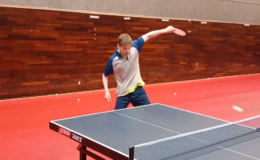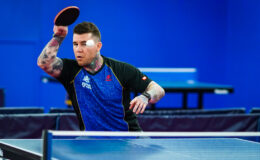By Larry Hodges, USATT Hall of Famer and Certified National Coach
This Tip is for those who wish to reach a high level of play, and who either play a looping style (like the large majority of top players) or are developing their style of play and aren’t sure what direction to go. The modern game at the higher levels is an incredibly athletic, fast, and spinny sport. What were considered incredible shots in the past are now routine as the looping game has developed to the current level. Part of this comes from training, part of it comes with the realization that these shots are possible, and part of it comes from modern sponges, which are far superior for looping than the ones from the past. (If I had some of these modern inverted surfaces back in the 70s and 80s. . . oh boy!)
The down side is that we’ve lost much of the hitter versus looper battles of yesteryear. Hitters dominated the 1960s, 70s, and much of the 80s, but by the 1990s loopers dominated, and now there are essentially zero hitters at the highest levels. What this means is that if you want to reach the highest levels, or even to reach a relatively high level, you probably should be looping as well. This doesn’t mean other styles can’t compete below world-class level, just that they are at a disadvantage. So unless you have a very good reason not to, you should develop your game as a looper. (There are also some world-class choppers, but they are not so much choppers as chopper/loopers, who primarily chop on the backhand, usually with long pips, and chop, loop, and counterloop on the forehand.)
What exactly does this mean? At its most basic level, it means if the ball comes long and you can see it, you should train to loop it. Period. (My definition here of “seeing it” is any ball that’s not coming at you so fast that you can’t really do anything other than reflex block or back up well off the table so you have more time.)
This doesn’t mean you can’t smash balls that are high, though many top players loop those as well. What it means is you don’t have time to make that split-second decision on whether to loop or do something else; that wastes time. Instead, assume you are going to loop it until proven otherwise, and react by immediately setting up to loop. If the ball comes at you so fast you simply can’t react in time to loop, then by all means do a reflex block or counter, or back up and fish and lob. But in general, as the ball comes out to you, you should be reflexively setting up to loop.
There is one other complication – should you loop on both sides or just on the forehand? These days I’d say both sides. There are still many players who reach high levels looping their forehand but mostly hitting their backhands, but even that can be a disadvantage at the higher levels, where these backhand hitters are turned into blockers. And yet a good, hard backhand hit or strong blocking game combined with a food forehand loop can take you pretty far. But looping from both sides can take you even farther – just watch the very best players and see how nearly all of them loop nearly everything from both sides.
So to expand on what all this means at its most basic level, here is some advice I tell up-and-coming juniors from the intermediate level up – and remember my definition above of “seeing it.”: On the forehand, if you can see it, loop it. If you can’t see it, back off and loop it. On the backhand, if you can see it, loop it. If you can’t see it, either block or back off and loop or fish.



